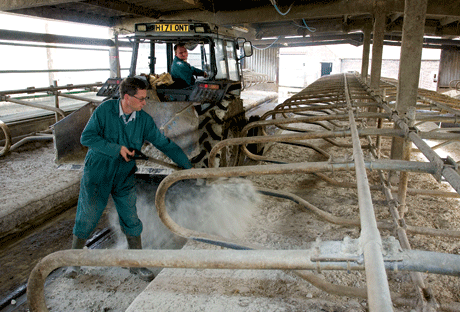Ash offers mastitis-beating dry bed

Dry beds are the death of mastitis-causing bacteria. One new form of bedding keeping beds dry and proving highly cost-effective, also ticks the green boxes.
This will be David Edge’s third winter bedding his dairy herd on waste-paper ash from a recycling plant. His 240-cow herd in Flintshire is just over the border from Chester and about two miles from a paper mill which recycles waste paper into newsprint.
Mr Edge is now one of several milk producers benefiting from an alternative bedding, while the mill reduces the amount of waste that might end up as landfill. The ash is produced from burning short fibre waste paper which comes from glossy magazines.
This paper can’t be recycled or spread on farmland. But burned, together with sustainable forest waste, it supplies enough energy to power one-third of the mill’s requirements, leaving large amounts of ash.
The ash is an odourless and strongly alkaline, grey-white gritty powder. According to Mr Edge, who houses his 7500kg herd in a mixture of cubicles and loose yards, it’s rather like a fine, white sand. “It’s a very dry product and arrives hot from the mill, but dust free. It’s also highly water absorbent and we can leave it outside without it getting really wet.”
This is because the mill mixes 15% water with the ash to suppress dust. When stored under cover, the ash eventually dries out and can become dusty. But stored outside, rain helps to form a cap over the heap and prevents ash from being blown around. Mr Edge shovels the ash up to 2.5cm (1in) deep twice a week on cow mattresses and heifer cubicles.

Waste ash from a recycling plant is providing a dry bedding which has the potential to help beat mastitis, reckons David Edge.
Shavings are then added on top of cow beds. “We have had it tested and it is 12.2 pH, which means bacteria can’t live on it – even after it has been soiled. Although we’ve had no problem in our system with automatic scrapers and the lagoon, we wouldn’t want to use it with slats,” he says.
Once the ash has mixed in with bedding muck and slurry, it rots down and can then be spread back on land. Another bonus is its liming potential. The ash has a neutralising value of about 32% standard lime is 55%. While Mr Edge can’t say this new bedding has specifically cut mastitis rates or cell counts, he has been able to reducing bedding time and frequency. “And we get the same results. I think it’s a good product.”
Gloucestershire-based vet Roger Blowey of Wood Vet Group is also convinced of the benefits. Anecdotal evidence from nine clients bedding their stock on ash, backs up his feeling that it is good for mastitis control by keeping conditions around the udder clean and dry. The environment is the reservoir of infection for environmental bacteria such as E coli which is present in dung and thrives in wet humid conditions.
Mr Blowey points out that wood, cardboard and paper fuelled power stations all produce a grey-white powder ash that could potentially be used for bedding. “Ash mixes well with sand and stays dry and friable. Or it can be spread 7.5cm (3″) deep under a straw yard to stop it heating up, or mixed with sawdust or shavings. Some producers are putting it on neat, although one farmer found it was too dusty,” he says.
Currently, Mr Blowey says that using ash works out at about £20/t which compares well against £90/t for shavings and £50/t for straw.
Ash for bedding
- Grey-white powder
- Alkaline
- Exceedingly dry
- Cost-effective
